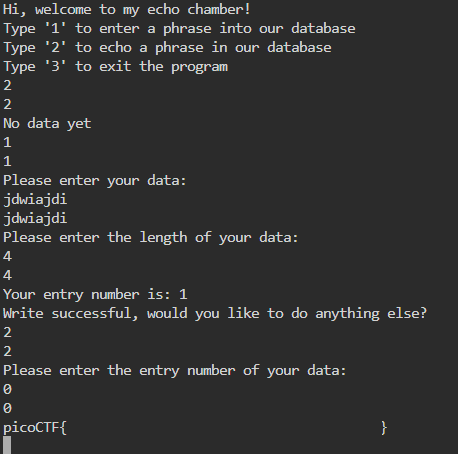W tym poście chciałbym opisać zadanie basic-file-exploit z picoCTF.
- #include <stdio.h>
- #include <stdlib.h>
- #include <stdbool.h>
- #include <string.h>
- #include <stdint.h>
- #include <ctype.h>
- #include <unistd.h>
- #include <sys/time.h>
- #include <sys/types.h>
- #define WAIT 60
- static const char* flag = "[REDACTED]";
- static char data[10][100];
- static int input_lengths[10];
- static int inputs = 0;
- int tgetinput(char *input, unsigned int l)
- {
- fd_set input_set;
- struct timeval timeout;
- int ready_for_reading = 0;
- int read_bytes = 0;
- if( l <= 0 )
- {
- printf("'l' for tgetinput must be greater than 0\n");
- return -2;
- }
- /* Empty the FD Set */
- FD_ZERO(&input_set );
- /* Listen to the input descriptor */
- FD_SET(STDIN_FILENO, &input_set);
- /* Waiting for some seconds */
- timeout.tv_sec = WAIT; // WAIT seconds
- timeout.tv_usec = 0; // 0 milliseconds
- /* Listening for input stream for any activity */
- ready_for_reading = select(1, &input_set, NULL, NULL, &timeout);
- /* Here, first parameter is number of FDs in the set,
- * second is our FD set for reading,
- * third is the FD set in which any write activity needs to updated,
- * which is not required in this case.
- * Fourth is timeout
- */
- if (ready_for_reading == -1) {
- /* Some error has occured in input */
- printf("Unable to read your input\n");
- return -1;
- }
- if (ready_for_reading) {
- read_bytes = read(0, input, l-1);
- if(input[read_bytes-1]=='\n'){
- --read_bytes;
- input[read_bytes]='\0';
- }
- if(read_bytes==0){
- printf("No data given.\n");
- return -4;
- } else {
- return 0;
- }
- } else {
- printf("Timed out waiting for user input. Press Ctrl-C to disconnect\n");
- return -3;
- }
- return 0;
- }
- static void data_write() {
- char input[100];
- char len[4];
- long length;
- int r;
- printf("Please enter your data:\n");
- r = tgetinput(input, 100);
- // Timeout on user input
- if(r == -3)
- {
- printf("Goodbye!\n");
- exit(0);
- }
- while (true) {
- printf("Please enter the length of your data:\n");
- r = tgetinput(len, 4);
- // Timeout on user input
- if(r == -3)
- {
- printf("Goodbye!\n");
- exit(0);
- }
- if ((length = strtol(len, NULL, 10)) == 0) {
- puts("Please put in a valid length");
- } else {
- break;
- }
- }
- if (inputs > 10) {
- inputs = 0;
- }
- strcpy(data[inputs], input);
- input_lengths[inputs] = length;
- printf("Your entry number is: %d\n", inputs + 1);
- inputs++;
- }
- static void data_read() {
- char entry[4];
- long entry_number;
- char output[100];
- int r;
- memset(output, '\0', 100);
- printf("Please enter the entry number of your data:\n");
- r = tgetinput(entry, 4);
- // Timeout on user input
- if(r == -3)
- {
- printf("Goodbye!\n");
- exit(0);
- }
- if ((entry_number = strtol(entry, NULL, 10)) == 0) {
- puts(flag);
- fseek(stdin, 0, SEEK_END);
- exit(0);
- }
- entry_number--;
- strncpy(output, data[entry_number], input_lengths[entry_number]);
- puts(output);
- }
- int main(int argc, char** argv) {
- char input[3] = {'\0'};
- long command;
- int r;
- puts("Hi, welcome to my echo chamber!");
- puts("Type '1' to enter a phrase into our database");
- puts("Type '2' to echo a phrase in our database");
- puts("Type '3' to exit the program");
- while (true) {
- r = tgetinput(input, 3);
- // Timeout on user input
- if(r == -3)
- {
- printf("Goodbye!\n");
- exit(0);
- }
- if ((command = strtol(input, NULL, 10)) == 0) {
- puts("Please put in a valid number");
- } else if (command == 1) {
- data_write();
- puts("Write successful, would you like to do anything else?");
- } else if (command == 2) {
- if (inputs == 0) {
- puts("No data yet");
- continue;
- }
- data_read();
- puts("Read successful, would you like to do anything else?");
- } else if (command == 3) {
- return 0;
- } else {
- puts("Please type either 1, 2 or 3");
- puts("Maybe breaking boundaries elsewhere will be helpful");
- }
- }
- return 0;
- }
Po analizie programu, możemy sprawdzić w jaki sposób należy uzyskać flagę.
Flaga zapisana jest w zmiennej flag:
- static const char* flag = "[REDACTED]";
Jej wyświetlenie pojawia sie w funkcji data_read():
- if ((entry_number = strtol(entry, NULL, 10)) == 0) {
- puts(flag);
- fseek(stdin, 0, SEEK_END);
- exit(0);
- }
Aby ją wyświetlić należy podać jako argument wartość 0. Wywołanie funkcji data_read następuje w głównej pętli programu.
- else if (command == 2)
- {
- if (inputs == 0) {
- puts("No data yet");
- continue;
- }
- data_read();
- puts("Read successful, would you like to do anything else?");
- }
Przed jej wywołaniem należy keszce wprowadzić jakieś dane. Przebieg odczytu flagi jest następujący:

